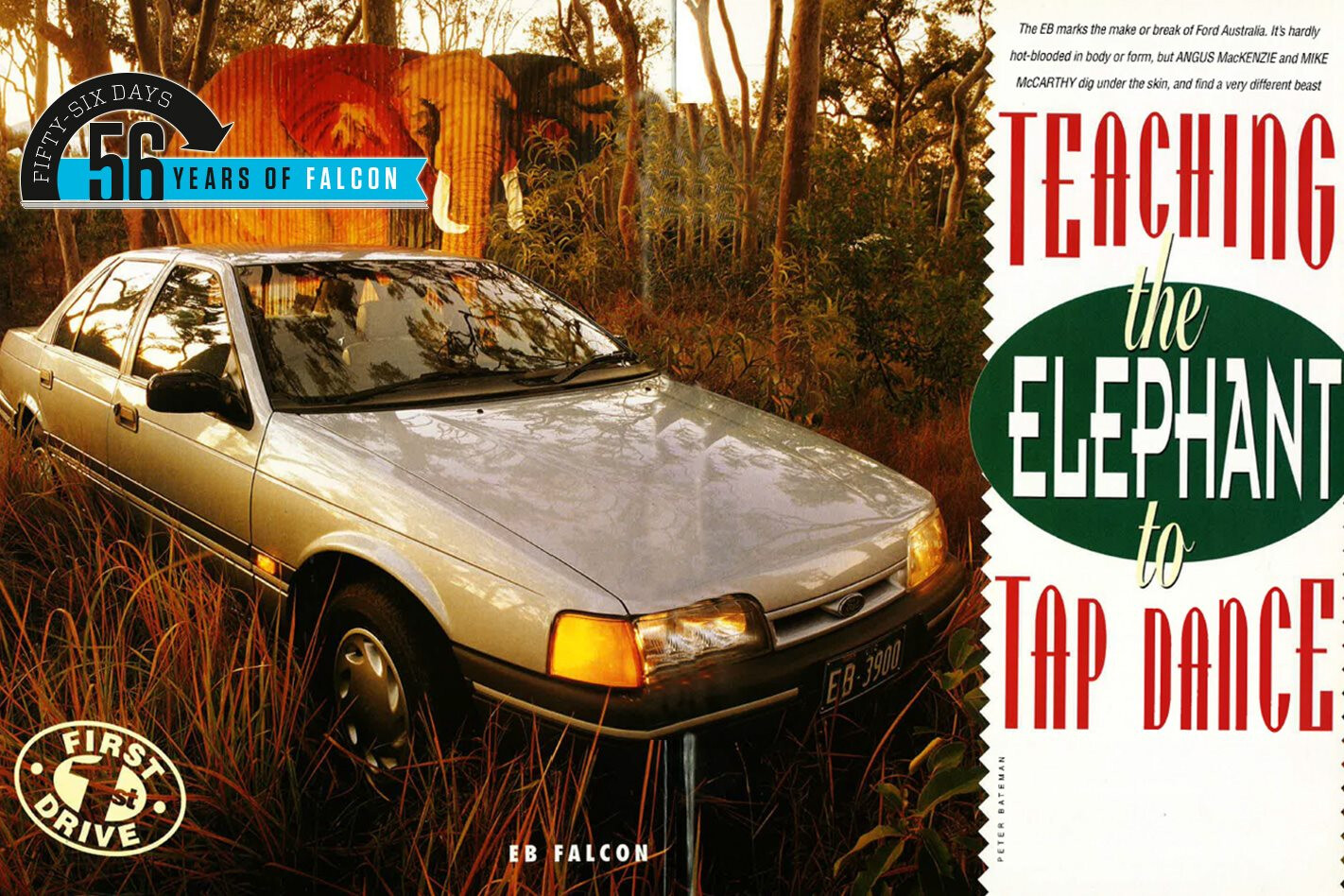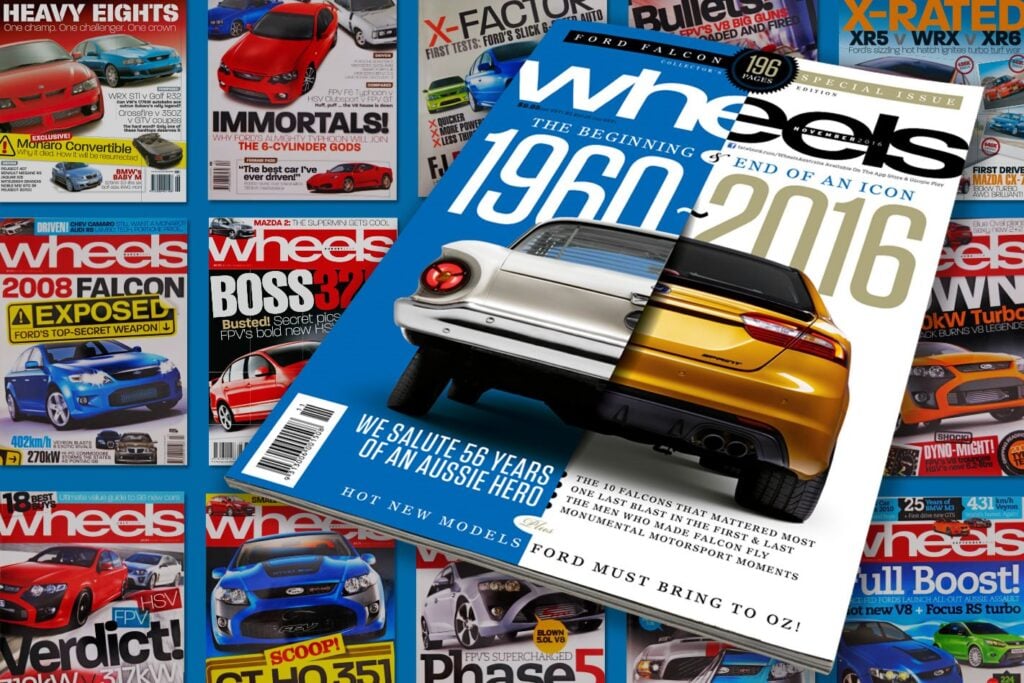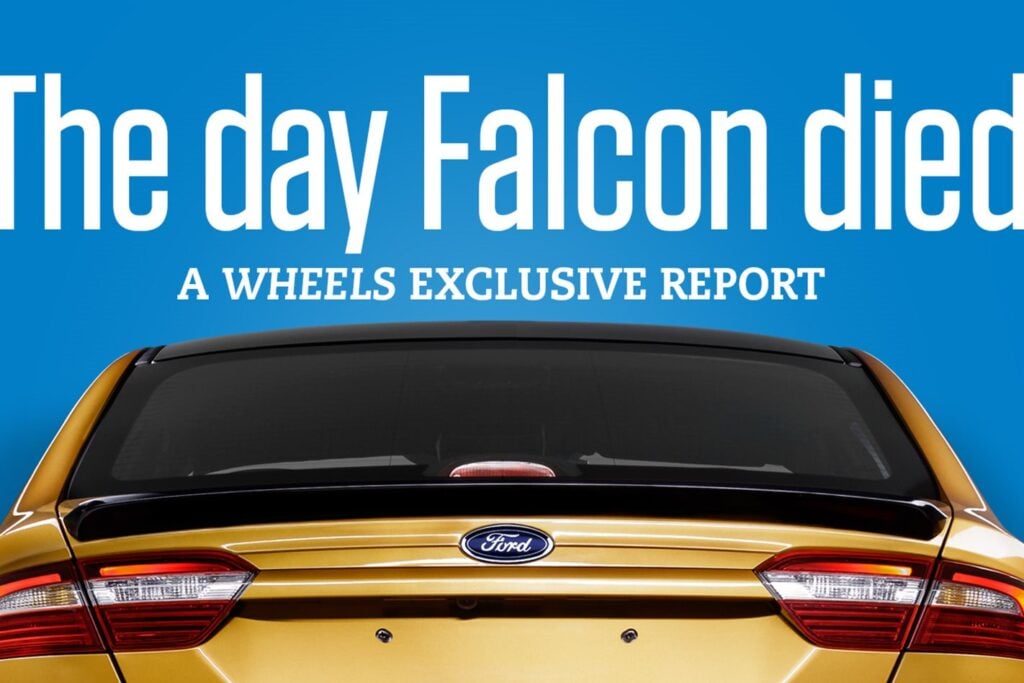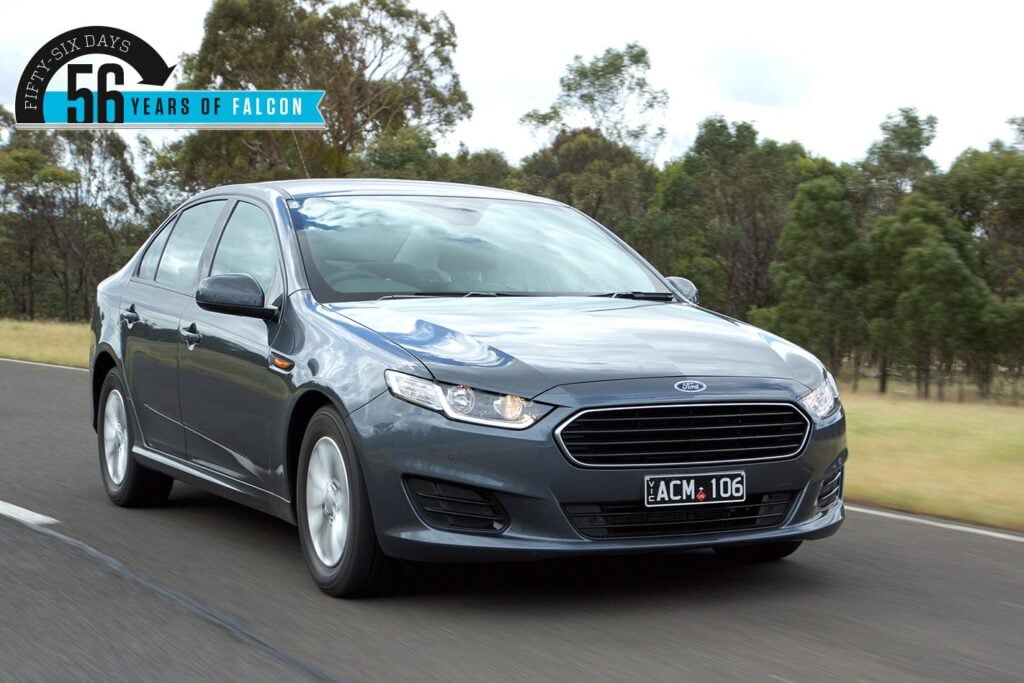First published in the August 1991 issue of Wheels magazine, Australia’s best car mag since 1953.
The EB marks the make or break of Ford Australia. It’s hardly hot-blooded in body or form, but ANGUS MacKENZIE and MIKE McCARTHY dig under the skin, and find a very different beast.
A repositioned badge here, a new taillight graphic there, or even the discreet burble of a 5.0 litre V8 isn’t going to convince anyone that Ford’s EB Falcon is really all that new.
More importantly, it isn’t going to convince anyone’s next-door neighbour. There’s not much driveway cred in new side repeater lamps …
Truth is, the EB probably represents the best $46 million Ford could have spent on the Falcon. It might look the same as the old model, but a host of detail engineering changes under the skin have transformed the way Ford’s family six rides and handles. Forget the woolly steering, the lazy turn-in response, the ponderous feel – Ford has taught the elephant to tap dance. In simple terms, EB spells RTS.
Yes, it’s every bit as good as Holden’s marshmallow-tomacho transformation in 1977. Of less obvious importance is the way Ford has quietly shuffled the equipment and options lists, mostly to the buyer’s benefit. The Fairmont, for example, now carries the same specification level as the old Ghia.
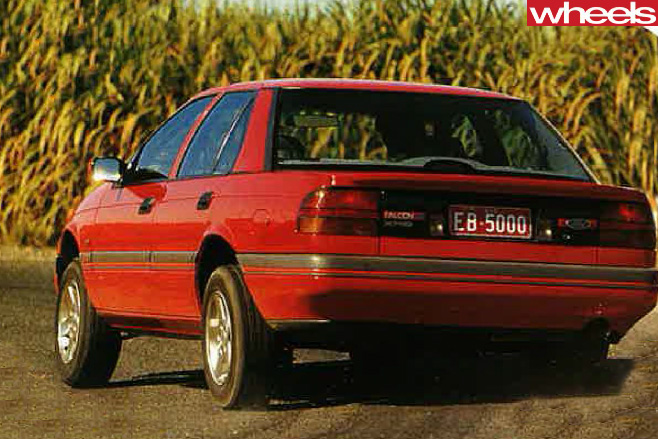
Which is exactly what Ford plans for 100,000 existing EA owners, via an extensive direct mail campaign to “Drive the Difference”. it’s hardly an inspiring slogan, but one Ford is taking very seriously, to the point where the dealer launch for the EB actually included a proper drive program before the drinks and the dancing girls – the first in maybe 20 years, according to one seasoned Ford marketing man.
The return of the V8, and the introduction of hotshoe models like the XR8, will grab most of the headlines of the EB launch story. But in a very real sense, the fuel injected 5.0 litre is simply high performance window dressing. Ford expects the V8 to account for no more than 15 per cent of total EB sales; the Falcon’s bread and butter will remain the six cylinder GL. For a basic, no frills motorcar, the Falcon GL is now a pretty well rounded package.
The standard throttle body version of the 3.9 litre straight six develops less power than the Commodore’s 3.8 litre V6, but has eight per cent more torque and is much more refined to boot, while BTR’s dual mode electronic four speed auto is a smoother, sweeter transmission than the General’s TH700.
Inside the GL, the tilt and reach adjustable steering wheel carries over from the Ford Falcon EA, combined with a new left footrest, seat height adjuster and lumbar support. The GL now gets central locking, as part of the ‘new high security Tibbe door locks introduced last year with the 30th anniversay upgrade. With two different engines,
two suspension settings and four different wheel/tyre combinations, there’s quite a variation in ride, handling and road-holding across the Falcon range. In all cases the improvement is palpable, but some combinations work better than others.
The bare bones EB GL is a quantum leap over the EA version. Turn-in response is crisp, almost a little too crisp at first, especially if tyre pressures are high – and steering feel much improved. The stiffer spring rates, uprated gas dampers and beefier bushes have cut excessive roll and weight transfer without unduly compromising ride quality, while larger 195 section tyres on wider six inch rims have increased the Falcon’s grip on the road. Some familiar Falcon traits remain – there’s still too much road noise, for instance, excessive wind roar from the exterior mirrors is still a problem, and rough corners leave you in no doubt there’s still a live rear axle doing the driving.
With an extra 24 kg over the front wheels, the V8 powered cars feel marginally more nose heavy than the sixes, particularly with the standard suspension settings. Balanced against this, however, is the ability to change the car’s attitude simply by squeezing your right foot. Be warned: without a limited-slip diff (standard fitment only on the XR8, Fairmont Ghia and LTD) you’ll mostly get a lot of noise and blue smoke from the inside rear tyre. If you order a V8 make sure you tick the box marked ‘LSD’.
Ford hasn’t spent $25 million on V8 related engineering, development, facilities and tooling just for show. The sales gap which has emerged between the Falcon and Commodore over the past two years -about 12,400 cars in all –has been entirely made up of Holden V8s. The EB V8’s job is to bridge that gap.
This is a smooth, sweet engine that with a manual gearbox behind it, spins freely well past the 5000 rpm redline. It’s not that thirsty, either – Ford claims consumption of 14.0 litres/100 km city and 9.0 litres/100 km highway for a GL V8 automatic. Holden’s official figures for its V8 Exec auto are 15.0 litres/100km city and 9.5 L/100 km on the highway cycle.
Although enthusiasts will opt for the T5 manual, in many ways the V8 delivers its best hooked up to the slick shifting BTR four speed auto, where the impressive torque- which peaks a full 600 rpm lower down the rev band than in Holden’s V8 – ensures instant response to throttle commands.
The V8 engine will be offered as an option across the Falcon range, from GL to Fairmont Ghia, sedan to wagon.
Final prices have yet to be decided, but expect to pay an extra $2500 for the V8 option.

The Statesman/Caprice has conservatively cost Ford dealers more than $130 million in retail sales, with Fairlane numbers falling 31 per cent, and LTD volume crashing 48 per cent. Ford admits Fairlane/LTD sales aren’t huge in terms of outright numbers, but the profit per car can be twice that of the Falcon.
The V8 is now standard equipment in the top of the range LTD. Apart from the EB-spec suspension mods and some minor cosmetic tweaking, very little else has been changed. The Fairlane line has been split into two models, a cheaper base spec version and the upmarket Fairlane Ghia. The base car is available only with the 3.9 litre six-cylinder and steel wheels and will be priced very close to Holden’s short wheelbase Calais. The Fairlane Ghia comes complete with BBS alloy wheels, LTD-style cloth trimmed front seats and is available with optional V8 power.
The top of the range Falcon is still the Fairmont Ghia. The EB version is quite different in character to its predecessor, however, as Ford has elected to fit the stiffer S-spec sports suspension, leather and velour-clad versions of the new Falcon XR8 sports seat, and BBS alloy wheels shod with Michelin tyres as standard equipment. It’s a much more sporty luxury sedan than the Calais.
The EB Fairmont has been extensively upgraded and refined. Standard equipment now includes the multi-point version of the 3.9 litre six, wider 15-inch EA Fairmont Ghia style alloy wheels, automatic climate control air-con, cruise control, trip computer, digital dash, and lashings of velour trim. Compared with the EA version, it’s virtually Fairmont Ghia spec, and should be one of the hottest sellers in the range.
The sporty Falcon S XR8 is covered in detail elsewhere in this issue. The six cylinder S version differs from its big engined cousin in having silver painted alloy wheels instead of machine finished items, and misses out on the rear bootlid spoiler. It doesn’t get the trick seats, either, making do with modified Capri backrests for improved side bolster support.
The sports suspension, which comprises stiffer spring and damper rates, plus a marginally lower ride height, seems to work best on the XR8. It’s firm, but not choppy, and the 205/65 Pirelli P600s cope well with small lumps and bumps.
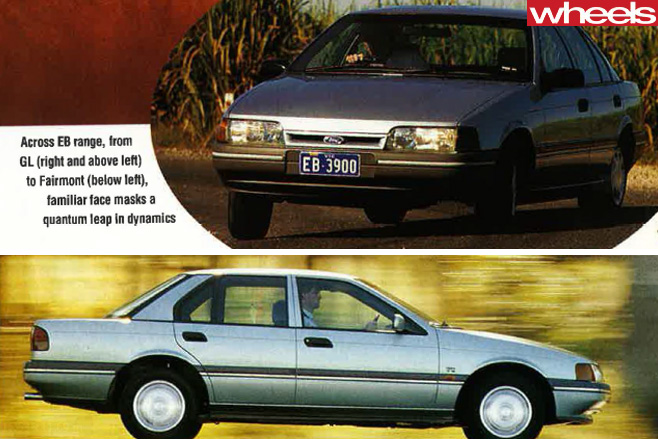
Ford Australia has a lot riding on the EB Falcon. This car has to be a winner if Ford is to fight off the Commodore, slow Toyota’s relentless slog towards market domination, and return to profitability. In the longer term, the success or failure of the EB will determine how much influence Ford Australia has in deciding the direction of the next generation Falcon.
Ford calls it the most important launch since the original 1960 Falcon. For once the PR hype might just be right…
Broadmeadows, Victoria, February 1983: meet the Falcon’s new fuel injected six cylinder engine. During the launch, lan Vaughan, Ford Australia’s Product Planning chief, refers to the November ’82 axing of the V8 engines and announces: “The world trend is towards smaller capacity engines. Five or six litre engines are a thing of the past; obviously we had to get out of there.”
Coolum, Queensland, June 1991: meet the new EB series Falcon … with a fuel-injected V8 engine. lan Vaughan, Ford Australia’s vice president of External Affairs, tells us the 1982 decision seemed like a good idea at the time. But with every passing year it became more obvious Ford had to get back in there, with a V8. it’s an engine they simply had to have.
For Ford, the importance of the V8 far outweighs the expected sales numbers. The company says that in a year’s projected 55,000 Falcon sales, only about 8250 will be V8s.
The new 5.0 litre’s role is not only as a powerful carrot for those who want a big engine, but also as an image-maker whose shine will rub off on the lesser models and help increase showroom traffic. Getting bums into seats is what it’s all about, and if the V8 stirs interest in people who wind up buying a Falcon, Fairmont or Fairlane six, well that’s alright.
Ford also figures the V8 will win sales in its own right, of course; some of them stepping up from the six cylinder models, some of them fresh conquests and some returning to Ford’s fold after trying other makes since ’82. After all, there’s a lot of tradition and sentiment in a Ford V8, especially one that’s familiar, if different in detail.
Even the engine’s family name has a ring to it – it’s a Windsor, albeit built in Ford’s Cleveland, USA plant. Today’s version pumps out 165 kW at 4500 rpm, and torques up a storm with 388 Nm at 3000 rpm.
Its tacho is redlined at 5000 rpm but, with the manual gearbox behind it, the engine easily sees six something in the intermediate ratios before the fuel cut-out activates.
The original 302 Windsor was imported for the Falcon from 1967 to 1973 when Ford switched to a locally produced 302 edition of the Cleveland version which, by the early ’80s, was claiming 140 kW and 344 Nm.
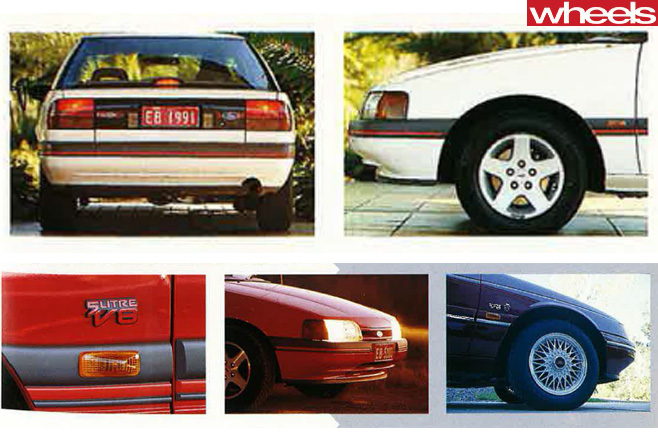
Internally, there’s a forged steel camshaft, roller followers and pressed steel rocker arms. Valve stems are chrome plated for long life, and rotators act on the exhaust valves to reduce seat deposits and lengthen seat life. Heads and block are thin-wall castings.
The 5.0 litre breathes through a new aluminium manifold, with sequential port injection, meaning the cylinders get their squirts in turn, like their electronically controlled sparks.
Instead of the six cylinder injection’s speed density air metering system, the EB V8 gets a hotwire mass flow air sensor.
Besides managing the VS’s ignition and injection, Ford’s EEC IV electronic system controls an exhaust gas recirculation (EGR) system to assure precise flow rates as needed to meet the tough nitrogen oxides standards. In all, the VS’s emissions control measures are almost identical to the US 49-States specification, and the Falcon in fact meets the much more stringent federal US exhaust levels.
Electronic engine control optimises not only the VS’s performance and exhaust emissions but also its fuel consumption.
On Ford’s official figures, the Ford VS is measurably more economical than comparable Holden models. The Falcon GL V8 automatic, for instance, is credited with 11.8 L/100 km for the combined city and highway cycles where the Holden Commodore Executive V8 auto manages 12.5 L/100 km. As manuals, the Falcon S and Executive V8s score 11.5 and 12.0 L/1 00 km respectively. The margins are a little wider again between the Ford Fairlane/LTD and Holden Statesman/Caprice.
The fabricated tubular headers not only do their bit for performance and fuel economy but also weigh less than cast exhaust manifolds. Weight’s further reduced with a permanent magnet, geared drive starter motor, aluminium intake manifold and an alloy clutch housing.
Those and other detail savings mean the new engine weighs some 90 kg less than the old 302C and isn’t much heftier than the 3.9 litre six.
Quite a few changes were necessary to adapt the engine from its USA spec to suit the Falcon. Known as the MN12, the 5.0 litre V8 is the heart of the Ford Mustang, Ford Thunderbird and the Mercury Cougar.
The Windsor needed new exhaust manifolds, intake manifold, air cleaner and clutch housing to suit the Falcon’s dimensions and right-hand drive steering. it also got a new sump, oil pump pick-up and dip stick, to suit the Falcon’s behind-axle steering mechanism.
The engines are built and hot run in the Cleveland plant, then railed to Florida minus the front end accessory drive (FEAD), for shipment to Australia.
The FEAD fitted here before the engine goes into the Falcon isn’t from the current Mustang, but is the latest version with a single serpentine belt driving the power steering pump, alternator, air-con compressor and automatic belt tensioner which attach to the engine via aluminium brackets.
The drivetrain changes don’t stop at the engine. The V8 gets essentially the same electronically controlled dual-mode four speed automatic transmission as the six cylinder models. To suit the extra power there are some internal upgrades for reliability and durability, and most of those improvements benefit the six cylinder version too. All share the same transmission ratios but the final drive ratios range from 3.08 to 3.23 to 3.27 for the standard six, the multipoint efi six and the V8 respectively.
The manual gearbox, too, is an upgraded version of the T5 unit used in the Falcon sixes, with better gear material and higher quality bearings. The V8 also gets its own ratios, nominally a bit taller than the six’s, but runs the 3.27 diff versus 2.92 in the six cylinder models. The overall effect, then, is that the V8 is slightly lower geared in all except first.
All the major mechanical components in the EB suspensions carry over from the EA series, but many detail changes are included in the springs, dampers and geometry for the sake of improved handling with better ride and roll control. The camber setting, for instance, goes from 0.5 degrees positive (EA) to 0.5 degrees negative (EB), while castor is increased by one degree to 3.5 degrees.
The cars’ rear suspension gets firmer bushings for improved axle control. All sedans bar the Falcon S and Fairmont Ghia have standard front springs; rear spring rate is 20 per cent firmer than before. Nitrogen charged gas shocks replace the EA’s plain hydraulic dampers on the front of all models, and on the rear of all but the Fairlane and LTD which have self-levelling dampers.
To improve the steering’s feel at straight ahead and sharpen its response to driver inputs, the variable system’s on-centre ratio has been quickened from 21.3:1 to 18.5: 1, and the previous rubber insulators have been discarded so the steering rack attaches direct to the chassis. One thing not discarded is the height/reach adjustable steering column included in all models apart from the GL sedan and wagon with standard 3.9 engine, column-shift automatic transmission and Centafold bench front seat.
Six cylinder models benefit from new normal-duty brake pads which suppress the squeal that often afflicted EA brakes in wet or dusty usage. In keeping with its higher performance potential, the V8 brings semi-metallic pads to the front brakes, revised front/rear pressure proportioning, and a dual diaphragm booster instead of the single unit used in the sixes.
None of these myriad detail changes are evident from the outside, of course. After three-and-a-half years, the EA bodyshell hasn’t changed a whit.
Good as it is, it was due for a trip to the beautician. That Ford spent $46 million on gym membership instead, placing new muscle and agility ahead of style can only be applauded.
But in an era of short design life and rapid change, substance alone may not be enough…

